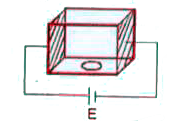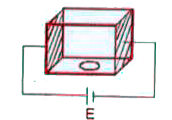Calculate the ionic mobility of colloidal particles in arsenic colloidal solution, if zeta potential is 0.045V (Dielectric
constant = 81, Viscosity of liquid=1.008 centipoise)
The correct Answer is:2.88cm2volt−1s−1.
To calculate the ionic mobility of colloidal particles in an arsenic colloidal solution, we will use the given data and the formula for ionic mobility. Here are the steps to solve the problem:
Step 1: Write down the given data.
- Zeta potential (ζ) = 0.045 V
- Dielectric constant (ε) = 81
- Viscosity (η) = 1.008 centipoise
Step 2: Convert viscosity from centipoise to SI units.
- 1 centipoise = 0.001 Pa·s
- Therefore, η = 1.008 centipoise = 1.008 × 0.001 Pa·s = 0.001008 Pa·s
Step 3: Write the formula for ionic mobility (U).
The formula for ionic mobility is given by:
U=2⋅ζ⋅ε3⋅η
Step 4: Substitute the values into the formula.
Now, substituting the values into the formula:
U=2⋅0.045⋅813⋅0.001008
Step 5: Perform the calculations.
First, calculate the numerator:
2⋅0.045⋅81=7.290
Next, calculate the denominator:
3⋅0.001008=0.003024
Now, divide the numerator by the denominator:
U=7.2900.003024≈2412.5cm2/V⋅s
Step 6: Round the answer to two decimal places.
Thus, the ionic mobility U is approximately:
U≈2412.5cm2/V⋅s
Final Answer:
The ionic mobility of colloidal particles in the arsenic colloidal solution is approximately 2412.5 cm²/V·s.
---
- Zeta potential (ζ) = 0.045 V
- Dielectric constant (ε) = 81
- Viscosity (η) = 1.008 centipoise
- 1 centipoise = 0.001 Pa·s
- Therefore, η = 1.008 centipoise = 1.008 × 0.001 Pa·s = 0.001008 Pa·s
The formula for ionic mobility is given by:
U=2⋅ζ⋅ε3⋅η
Now, substituting the values into the formula:
U=2⋅0.045⋅813⋅0.001008
First, calculate the numerator:
2⋅0.045⋅81=7.290
3⋅0.001008=0.003024
U=7.2900.003024≈2412.5cm2/V⋅s
Thus, the ionic mobility U is approximately:
U≈2412.5cm2/V⋅s
The ionic mobility of colloidal particles in the arsenic colloidal solution is approximately 2412.5 cm²/V·s.
Topper's Solved these Questions
- SURFACE CHEMISTRY Book:AAKASH INSTITUTE ENGLISHChapter:SURFACE CHEMISTRY Exercise:ASSIGNMENT SECTION - J
Explore 6 Videos
- SURFACE CHEMISTRY Book:AAKASH INSTITUTE ENGLISHChapter:SURFACE CHEMISTRY Exercise:Exercise
Explore 20 Videos
- SURFACE CHEMISTRY Book:AAKASH INSTITUTE ENGLISHChapter:SURFACE CHEMISTRY Exercise:ASSIGNMENT SECTION - H
Explore 2 Videos
- STRUCTURE OF ATOM Book:AAKASH INSTITUTE ENGLISHChapter:STRUCTURE OF ATOM Exercise:ASSIGNMENT ( SECTION -J) Aakash Challengers Questions
Explore 12 Videos
- TEST 1Book:AAKASH INSTITUTE ENGLISHChapter:TEST 1Exercise:EXAMPLE
Explore 134 Videos
Similar Questions
A solution which remains in equilibrium with undissolved solute , in contact , is said to be saturated . The concentration of a saturated solution at a given temperature is a called solubility . The product of concentration of ions in a saturated solution of an electrolyte at a given temperature is called solubility product (Ksp) . For the electrolyte Ax,By with solubility S.
The solubility product (Ksp) is given as Ksp=xx×yy×Sx−y . While calculating the solubility of a sparingly . soluable salt in the presence of some strong electrolyte containing a common ion , the common ion concentration is practically equal to that of strong electrolyte containing a common ion . the common ion soncentration is practically equal to that of strong electrolyte . If in a solution , the ionic product of an electroylte exceeds its Ksp value at a particular temperature , then precipitation occurs . If two or more electrolyte are presentt in the solution , then by the addition of some suitable reagent , precipitation generally occurs in increasing order of their ksp values . Solubility of some sparingly soluable salts , is sometimes enhanced through complexation . While we are calculating the solubility of some sparingly or pH of an electrolyte , the nature of cation of anion should be checked carefully whether there ion (s) are capable of undergoing hydrolysis or not . If either or both of the ions are capable of undergoing hydrolysis , it should be taken into account in calculating the solubility . While calculating the pH of an amphiprotic species , it should be checked whether or not cation can undergo hydrolysis . Total aH−=√Ka1×Ka2 (if cation do not undergo hydrolysis )
aH+=√Ka1(KwKb−Ka2) (if cation also undergoes hydrolysis ) where symbols have usual meaning . Solubility of solids into liquids is a function of temperature alone but solubility of gases into liquids is a function of temperature as well as pressure . The effect of pressure on solubility of gases into liquids is governed by Henry's law .
The solubility of BaSO4 in 0.1 M BaCl2 solution is (Ksp of BaSO4=1.5×10−9)
View SolutionA solution which remains in equilibrium with undissolved solute , in contact , is said to be saturated . The concentration of a saturated solution at a given temperature is a called solubility . The product of concentration of ions in a saturated solution of an electrolyte at a given temperature is called solubility product (Ksp) . For the electrolyte Ax,By with solubility S.
The solubility product (Ksp) is given as Ksp=xx×yy×Sx−y . While calculating the solubility of a sparingly . soluable salt in the presence of some strong electrolyte containing a common ion , the common ion concentration is practically equal to that of strong electrolyte containing a common ion . the common ion soncentration is practically equal to that of strong electrolyte . If in a solution , the ionic product of an electroylte exceeds its Ksp value at a particular temperature , then precipitation occurs . If two or more electrolyte are presentt in the solution , then by the addition of some suitable reagent , precipitation generally occurs in increasing order of their ksp values . Solubility of some sparingly soluable salts , is sometimes enhanced through complexation . While we are calculating the solubility of some sparingly or pH of an electrolyte , the nature of cation of anion should be checked carefully whether there ion (s) are capable of undergoing hydrolysis or not . If either or both of the ions are capable of undergoing hydrolysis , it should be taken into account in calculating the solubility . While calculating the pH of an amphiprotic species , it should be checked whether or not cation can undergo hydrolysis . Total aH−=√Ka1×Ka2 (if cation do not undergo hydrolysis )
aH+=√Ka1(KwKb−Ka2) (if cation also undergoes hydrolysis ) where symbols have usual meaning . Solubility of solids into liquids is a function of temperature alone but solubility of gases into liquids is a function of temperature as well as pressure . The effect of pressure on solubility of gases into liquids is governed by Henry's law .
The solubility of PbSO4 in water is 0.0303 g/l at 25∘C , its solubility product at that temperature is
View Solution(a) State the relationship amongst cell constant of a cell , resistance of the solution in the cell and conductivity of the solution . How is molar conductivity of solute related to conductivity of its solution ?
(b) A voltanic cell is set up at 25∘C with the following half-cells :
Al∣Al3+(0.001M) and Ni∣Ni2+(0.50M)
Calculate the cell voltage [E∘Ni2+∣Ni=−0.25V,E∘Al3+∣Al=−1.66V]
View SolutionThe particles of a particular colloidal solution of arsenic trisulphide (As2S3) are negatively charged. Which 0.0005 M solution would be most effective in coagulating this colloidal solution. KCl,MgCl2,AlCl3 or Na3PO4 ? Explain.
View SolutionCalculate the potential of silver electrode in a saturated solution of AgBr(Ksp=6×10−13) containing 0.1MKBr.Ec−.Ag⊕∣Ag=0.80V.
View Solution100 ml of a colloidal solution is completely precipitated by addition of 0.5 ml 1M NaCl solution, calculate the coagulation value of NaCl.
View SolutionPassage-I :
A hollow cube of side L has two parallel sides conducting and remaining four sides are non conducting. It is filled with a liquid of dielectric constant K. A small hole of area A at bottom of cube is open at t = 0 and liquid starts leaking throught it. The two conducting sides are connected by a battery of emf E (L=9mA=18√20m2k=10E=81v,g=10m/sec)

Capacitance of capacitor as a function of time
View SolutionPassage-I :
A hollow cube of side L has two parallel sides conducting and remaining four sides are non conducting. It is filled with a liquid of dielectric constant K. A small hole of area A at bottom of cube is open at t = 0 and liquid starts leaking throught it. The two conducting sides are connected by a battery of emf E (L=9mA=18√20m2k=10E=81v,g=10m/sec)

Capacitance of capacitor as a function of time
View SolutionPassage-I :
A hollow cube of side L has two parallel sides conducting and remaining four sides are non conducting. It is filled with a liquid of dielectric constant K. A small hole of area A at bottom of cube is open at t = 0 and liquid starts leaking throught it. The two conducting sides are connected by a battery of emf E (L=9mA=18√20m2k=10E=81v,g=10m/sec)

Current through the connecting wire of a time is given by
View SolutionA system of greater disorder of molecules is more probable. The disorder of molecules is reflected by the entropy of the system.A liquid vapourises to form a more disordered gas.When a solute is present, there is additional contribution to the entropy of the liquid due to increased randomness.As the entropy of solution is higher than that of pure liquid, there is weaker tendency to form the gas.Thus, a solute (non-volatile) lowers the vapour pressure of a liquid, and hence a higher boiling point of the solution.
Similarly, the greater randomness of the solution opposes the tendency to freeze.In consequence, a lower the temperature must be reached for achieving the equilibrium between the solid (frozen solvent) and the solution.Elevation of B.Pt.(ΔTb) and depression of F.Pt.(ΔTf) of a solution are the colligative properties which depend only on the concentration of particles of the solute, not their identify.For dilute solutions. ΔTbandΔTf are proportional to the molality of the solute in the solution.
ΔTb=Kbm,Kb=Ebullioscopic constant=RT∘2bM1000ΔHvap
And ΔTf=Kfm,Kf=Cryoscopic constant=RT∘2fM1000ΔHfus (M=molecular mass of the sovent)
The values of KbandKf do depend on the properties of the solvent.For liquids, ΔHvapT∘b is almost constant.
[Troutan's Rule, this constant for most of the unassociated liquids (not having any strong bonding like Hydrogen bonding in the liquid state ) is equal to 90J/mol.]
For solutes undergoing changes of molecular state is solution (ionization or association), the observed ΔT values differ from the calculated ones using the above relations In such situations, the relationships are modified as ΔTb=iKbm,ΔTf=iKfm
where i=Van't Hoff factor, greater than unity for ionization and smaller than unity for association of the solute molecules.
A mixture of two Immiscible liquids at a constant pressure of 1 atm boils at a temperature
View Solution